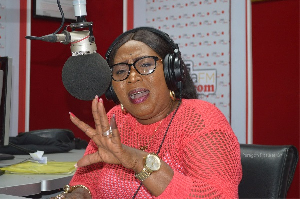The Bank of Ghana has maintained its policy rate at 16 percent for the third time this year.
Addressing a press conference Wednesday, Governor of the Bank of Ghana, Dr. Kofi Wampah said the central bank will continue to monitor developments and take appropriate actions if required.
BELOW IS THE BANK OF GHANA STATEMENT
You are welcome to this Press briefing. The Monetary Policy Committee (MPC) held its 58th meeting on November 25 to 27, 2013 to review the latest economic developments and the monetary policy stance. I present to you the outcome of the deliberations.
Global Economic Developments
The latest projections by the IMF indicate a pickup in the pace of global activity from 2.9 percent in 2013 to 3.6 percent in 2014, driven largely by the advanced economies with the impulse to global growth expected to come mainly from the United States against weaker prospects in emerging market economies.
Growth in Sub-Saharan Africa remained robust and is expected to accelerate to 6 percent in 2014, emanating from strong domestic demand. However, spillovers from sluggish external demand, reversal of capital flows, and declines in commodity prices could moderate the growth prospects.
On global inflation, pressures are generally subdued, with global headline inflation below 3 percent. In advanced economies, inflation is running below target, at about 1.5 percent on average. The return to target is projected to be slow given that output is expected to gradually return to potential. In emerging markets and developing economies, inflation has eased to around 5-6 percent, consistent with sluggish activity and lower commodity prices.
Commodity prices are expected to remain low on the international markets during the fourth quarter of 2013. Crude oil prices are forecast to average $107 per barrel at the end of 2013, while a bearish outlook for gold is expected despite assurance that the US FED will keep its stimulus program unchanged for a while.
The realized price for gold has averaged $1,464 for the year to September, and is forecast to end the year around $1,306. On the other hand, the market for cocoa beans is expected to be bullish in the fourth quarter of 2013 and expected to range between US$2,550 and US$2,710 per tonne at the end of 2013. These developments in the external environment continue to feed through to the domestic economy through trade, finance and exchange rate channels.
Domestic Economic Developments
Inflation and Growth
Since the last MPC meeting, inflationary pressures have increased. Headline inflation rose from 11.5 percent in August to 13.1 percent in October. Non-food inflation was the main driver as it picked up from 14.2 percent to 17.7 percent while food inflation declined from 7.9 percent to 6.9 percent.
The updated real CIEA data suggests a continued rise in economic activity in the third quarter of 2013. At the end of September 2013, the real CIEA grew by 7.5 percent from the 5.8 percent recorded in July. The key drivers of economic activity for the third quarter were DMBs credit to the private sector, industrial consumption of electricity, SSNIT contributions and port activity.
The consumer and business confidence indices fell during the period. The overall consumer confidence index stood at 89.3 in October, down from 97.2 in August. Similarly, the business sentiments indicator dipped to 90.8 in September from 92.4 in June. The surveys also indicated heightened inflation expectations by both consumers and businesses.
Government Fiscal Operations
Provisional data on the execution of the 2013 budget for the first nine months of the year show that both revenue and expenditure fell short of their respective targets. However, the shortfall in revenue was much higher than the reduction in expenditure.
Total revenue and grants amounted to GH¢13.9 billion (15.9% of GDP) falling short of the target of GH¢16.3 billion (18.4% of GDP). The shortfall in government receipts was mainly the result of lower than budgeted domestic revenue collections on account of lower import volumes, decline in commodity prices on the world market and slowdown in economic activity during the first half of the year, due partly to the energy crisis.
Total expenditure, including payments made for the clearance of arrears and outstanding commitments, was GH¢21.2 billion (24.3% of GDP) compared with the budgeted ceiling of GH¢22.7 billion (26.1% of GDP). Compensation of employees of GH¢6.6 billion and interest payments of GH¢3.3 billion, represented 74.1 per cent of domestic revenue.
The overall budget deficit for the first nine months of 2013, was GH¢7.3 billion equivalent to 8.4 per cent of GDP, against a target of 7.2 per cent. The deficit was financed mainly from the domestic sector, resulting in a Net Domestic Financing of the budget of GH¢5.1 billion (5.9% of GDP), compared with the budget target of GH¢4.7 billion (5.4% of GDP).
The total public sector debt stock as at end of September 2013 was GH¢46.1 billion (53.5% of GDP), up from GH¢35.1 billion at the end of December 2012. The total public sector debt was made up of a domestic debt stock of GH¢24.9 billion, up from GH¢18.5 billion in December 2012 and external debt stock of US$10.8 billion, up from US$8.8 billion as at the end-December 2012.
Monetary and Banking Sector Developments
For the first ten months of the year broad money (M2+) grew by 20.8 percent, compared with 21.9 percent in the same period last year. This was largely on account of a sharp slowdown in growth of foreign currency deposits, even though this was moderated by increases in domestic currency deposits.
The latest Bank of Ghana survey of credit conditions showed a general tightening of credit. The credit stance for all loan types tightened during the period. The survey also showed that the number of loan applications from households, SMEs and large enterprises, a measure of credit demand, decreased. Among the principal reasons cited for rejection of loan applications included, poor credit history, low cash flows, inadequate security, weak management and weak financials.
The pace of annual growth in private sector credit slowed to 25.0 percent at the end of October 2013, compared to 44.3 percent during the same period in 2012. Similarly, the annual growth of real private sector credit was 10.5 percent in October 2013, compared to a 30.5 percent growth in 2012.
Ghana's banking sector continued to record strong growth during the first nine months of the year. The sector remained relatively stable, benefiting from healthy capitalisation as well as sound liquidity and profitability.
Total assets of the banking industry as at the end of September 2013 rose to GH¢33.9 billion, from GH¢25.1 billion in September 2012. This was driven mainly by advances, which accounted for 46.6 per cent of the total. The asset growth was mainly funded by deposits which recorded an annual growth of 18.1 per cent to GH¢21.1 billion at the end of September 2013.
The non-performing loans (NPL) ratio within the banking industry decreased to 12.3 percent in September 2013, from 13.1 percent in September 2012, while the ratio excluding the loss category, declined to 5.0 percent from 6.5 percent in the same period last year. Interest rates on the money market have broadly declined. Between December 2012 and October 2013:
The 91-day instrument declined to 19.9 percent from 23.1 percent. Similarly, the 182-day declined to 19.9 from 23.0 percent.
The 1-year note rate fell to 19.0 percent from 22.9 percent, while the rate on the 2-year note declined to 19.3 percent from 23.0 percent.
The 3-year bond rate fell to 19.2 from 21 percent. The rate on the 5-year bond issued in September was 19.0 percent.
The weighted average interbank rate declined to 16.7 percent from 17.5 percent in December 2012. Average lending rates of the banks declined marginally to 25.6 percent in October 2013, from 25.7 percent in December 2012. The average rate on 3-month term deposits remained unchanged at 12.5 percent, narrowing the spread marginally to 13.1 percent in October 2013, compared with a spread of 13.2 percent in December 2012.
External Sector Developments
For the first nine months of 2013, the balance of payments improved as it recorded a lower deficit of US$1.7 billion compared with a deficit of nearly US$2.1 billion in the same period last year. This was largely due to increased net inflows to the financial account, in spite of a deterioration in the current account deficit.
The current account deficit widened to US$4.5 billion from the US$4.1 billion recorded in the corresponding period of 2012. This was as a result of a deterioration in the services, income and transfers account, which was moderated by an improvement in the trade balance.
The capital and financial accounts on the other hand recorded a significant rise in the surplus to US$3.4 billion from a surplus of US$1.7 billion in the same period of 2012. This development was mainly driven by net official borrowing of US$1.3 billion and significant improvement in the deficit on short term capital.
For the first ten months of the year, the value of merchandise exports remained broadly unchanged at US$11.4 billion compared to the same period last year. Earnings from gold fell by 12.0 percent to US$4.2 billion, while exports of cocoa beans also declined by 33.5 percent to US$1.3 billion partly reflecting a decline in the prices of the commodities. Oil exports, however, increased by 30.9 percent to US$3.2 billion, as a result of increased production. Earnings from non-traditional exports, including cocoa products, went up by 25.8 percent to US$2.2 billion.
The value of imports was unchanged at US$14.7 billion. Oil imports went up by 0.4 per cent to US$2.9 billion, while non-oil imports declined by 0.2 per cent to US$11.8 billion within the period. Of non-oil imports, the share of capital and intermediate goods declined to 68 percent from 70 percent in 2012, while consumption goods increased to 24 percent from 22 percent. The trade deficit for the period therefore remained unchanged at US$3.4 billion.
As at November 20, 2013 the Ghana cedi had depreciated at a slower rate of 9 percent against the US dollar, compared with 17.4 percent during the same period in 2012. The real effective exchange rate appreciated by 2.8 percent during the period.
Private inward transfers received through the banking system from January to September 2013 declined to US$12.6 billion from US$13.4 billion for the same period in 2012. Of the total transfers, US$1.3 billion accrued to individuals representing a decline of 0.4 per cent over the same period of 2012.
Gross international reserves amounted to US$5.6 billion (2.9 months of imports) in November 2013 from a stock position of US$5.3 billion (3 months of imports) at the end of December 2012.
Summary and Outlook
Prospects for global economic growth remained steady in spite of changing dynamics from emerging market economies to the advanced economies. However there are significant downside risks in the external environment that could impact on economic developments going forward.
Performance in the domestic economy will therefore be subject to these developments through the external channel. In particular, economic recovery in the Euro area as well as favourable commodity price developments in the international markets could impact external sector performance. However, the negative outlook for gold prices would have an adverse impact.
On growth prospects, the Committee took into cognisance the uptick in the CIEA during the third quarter of 2013. The continued improvements in the energy sector, the expected increases in oil production and the onset of gas production could support the growth momentum into 2014. This notwithstanding, the Committee was wary of lingering uncertainties in world commodity markets, and the continued bearish consumer and business expectations as well as tightened credit conditions, that could impact on the outlook.
The local currency experienced a relatively slower depreciation against the US Dollar compared to the same period last year. However, the Committee noted that there were vulnerabilities in the foreign exchange markets, especially since the last MPC round. Additional measures will be introduced to help increase transparency in the markets.
The Committee noted that inflation pressures had increased since the last MPC round as headline inflation drifted outside the target band. This was mainly on account of the removal of subsidies on petroleum and increased tariffs on utilities. There were also demand pressures emanating from budget overruns, and exchange rate pressures.
In assessing the outlook for inflation, the Committee noted that the upside risks identified in the earlier MPC rounds had actually crystalized in the form of pass-through of petroleum price and electricity tariff adjustments, as well as continued fiscal and exchange rate pressures.
However, it is expected that the fiscal measures announced in the 2014 budget, if realized, would mitigate some of the pressures. The Committee concluded that headline inflation will breach the 2013 target. Looking ahead however, our forecasts show that inflation will track back to the target band of 9.5±2 by the end of 2014, barring any new shocks.
The Committee held the view that the upside risks to inflation, though elevated, are mainly structural and therefore may not need to be addressed by a policy rate adjustment at this time. On the other hand there are no significant risks to growth. Consequently, the Committee decided to maintain the policy rate at 16.0 percent. The Committee will continue to monitor developments and take appropriate action if required.
Other Measures
In addition to the policy rate decision, the Central bank will introduce the following:
A new set of foreign exchange regulations and code of conduct to guide operations in the foreign exchange market. This will ensure transparency and streamline activities in the foreign exchange market. A review of the Foreign Exchange Act, 2006 (Act 723) for easy application and enforcement.
A uniform trade reporting platform for all banks to ensure transparency in pricing, price discovery, and online reporting.
The Bank is in discussions with the Ministry of Finance to allow foreign participation in the 1 and 2 – Year Government of Ghana securities transactions. This is to ensure competitive pricing in the market.
Business News of Thursday, 28 November 2013
Source: radioxyzonline

















